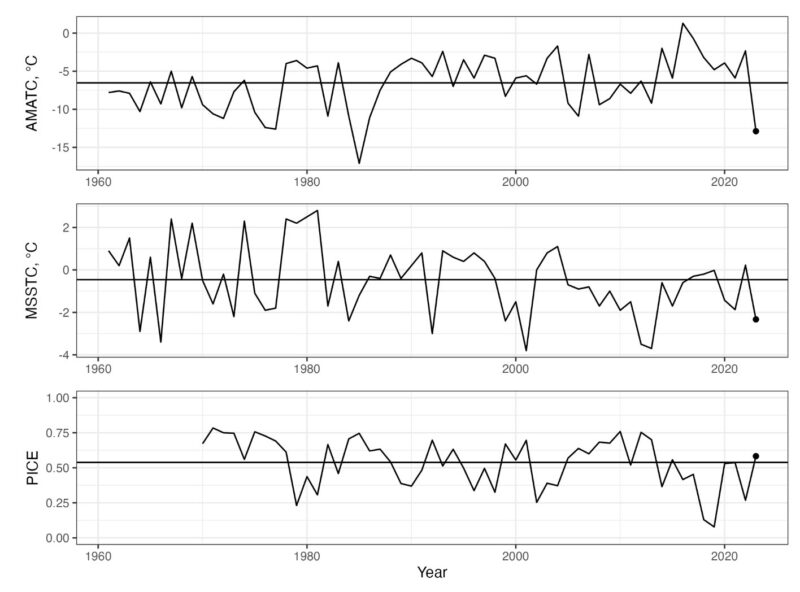Yukon River Chinook are predicted to arrive on the delta later than average in 2023: The first significant pulse (15% point) is expected by June 20th and 50% of the run is expected to have arrived by June 26th.
Spring 2023 brought with it below average temperatures across the state and record low temperatures in Western Alaska[1][2]. All three established environmental indicators of run timing[3] trended cold in the Spring of 2023 (Figure 1). April mean air temperature at the Nome, AK airport (AMATC) was -12.9°C, considerably cooler than the long-term average of -6.5°C (range -17.1°C to 1.3°C). May mean sea surface temperature (MSSTC) measured along the migratory route between the delta and St. Lawrence Island was -2.3°C, also considerably cooler than its long-term average of -0.46°C (range -3.8°C to 2.8°C). Spring-time ice cover between the delta and St. Lawrence Island was slightly above average at 58% (average 54%, range 8% to 78%).

Figure 1: A three-panel plot, each panel showing time series of April mean air temperature (AMATC) at the Nome AK airport, May mean sea surface temperature in the nominal marine staging area (MSSTC), and the proportion of ice cover (PICE) in the nominal marine staging area. Solid vertical line mark indicates each series’ long-term mean and a solid circle mark indicates the 2023 value in each series.
Forecast Detail
The forecast model is based on the relationship previously established in Mundy & Evenson (2011)3 which identified a set of three environmental variables which correlate with the run timing of Yukon River Chinook: April mean air temperature at the Nome, AK airport (1961–2023; AMATC), May mean sea surface temperature (1961–2023; MSSTC) in the nominal marine staging area just off the Yukon River Delta, and the Spring-time proportion of ice cover (1970–2023; PICE), also measured over the nominal marine staging area. The forecast model is made of three independent sub-models, where each sub-model is a multiple linear regression with a response of either the 15th (FIFDJ), 25th (QDJ), or 50th (MDJ) percentile of cumulative catch-per-unit effort (CPUE) in either commercial or test fisheries located on the delta (1961–2022). Based upon the historical relationship with CPUE in commercial and test fishery catches on the Yukon River Delta (1961–2022) and the previously mentioned environmental indicators (AMATC, MSSTC, PICE), the predicted dates of three percentiles of CPUE in the Lower Yukon Test Fishery are June 20th (15%), June 22nd (25%), and June 26th (50%) (Table 1).

Table 1: Predicted dates (June 20th, 22nd, 26th) of three percentiles (15%, 25%, 50%) of cumulative catch-per-unit-effort (CPUE) and the associated model formula for each.
A midpoint of June 26th is five days later than the long-term average 50% point and would make this year’s run the latest since 2015.
Forecast Performance
We quantified the accuracy of the forecast sub-models using hindcasting with the most recent fifteen years of runs and calculated a set of prediction-oriented evaluation criteria for each (Table 2). All three sub-models (FIFDJ, QDJ, MDJ) perform similarly, with mean absolute prediction errors (MAPE) 2.27–2.93 days. We also calculated prediction intervals by multiplying each model’s standard error by 2σ to get interval widths ranging from 7.6–8.1 days, which contained the observed value 73–87% of the time. Last, we calculated the maximum absolute residual of 6–9 days and prediction bias of -1.87 to -0.53 days which means the model tends to make forecasts slightly earlier than observed run timing. The forecast’s bias is an area for future forecast improvements.

Table 2: Model performance metrics for the three sub-models that make up the forecast. MAPE: Mean Absolute Prediction Error and its standard deviation. Bias is the mean residual. Max. Residual is the maximum absolute residual.
See the project website as the season progresses for up to date information about how catches at LYTF match the forecast and historical comparisons of catch data. For more information about how the forecast was produced, see https://github.com/yukon-forecasting/2023-forecast. For more information on the forecast model and its underlying biological hypothesis, see Mundy & Evenson (2011)3.
Acknowledgements
Prepared by Bryce Mecum (brycemecum@gmail.com). Data management and web page support by Holly Kent (kent@aoos.org) and Aidan Lewis (aidan@axiomalaska.com). Yukon Chinook in-season salmon data and management agency coordination by Fred West (fred.west@alaska.gov). Financial and material support provided by the Alaska Ocean Observing System, NOAA National Marine Fisheries Service, and the Alaska Department of Fish & Game.
References
[1] https://www.ktoo.org/2023/06/06/alaskas-spring-was-colder-than-average-while-other-places-baked
[2] https://nsidc.org/arcticseaicenews/2023/06/springing-into-summer/
[3] Phillip R. Mundy, Danielle F. Evenson, Environmental controls of phenology of high-latitude Chinook salmon populations of the Yukon River, North America, with application to fishery management, ICES Journal of Marine Science, Volume 68, Issue 6, July 2011, Pages 1155–1164, https://doi.org/10.1093/icesjms/fsr080
